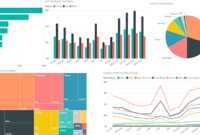Data consolidation involves combining data from various sources to improve data management efficiency. This process is crucial for organizations looking to enhance decision-making and streamline their operations.
In today’s data-driven world, the ability to consolidate and integrate data seamlessly can provide a competitive edge and drive success across industries. Let’s dive deeper into the realm of data consolidation and uncover its significance.
Overview of Data Consolidation
Data consolidation is the process of combining data from multiple sources into a single, unified view. This is essential for organizations to ensure that they have accurate and consistent data for analysis, reporting, and decision-making. By consolidating data, companies can eliminate data silos, reduce errors, and improve data quality.
Significance of Data Consolidation
Data consolidation plays a crucial role in data management by providing a comprehensive and cohesive view of an organization’s information. It helps in streamlining processes, improving efficiency, and enabling better insights into business operations. Without data consolidation, companies may struggle with data inconsistencies, duplication, and inaccuracies.
Examples of Industries/Scenarios
Various industries benefit from data consolidation, including finance, healthcare, retail, and manufacturing. For example, in the finance sector, consolidating customer data from multiple systems can help banks offer personalized services and detect fraudulent activities. In healthcare, consolidating patient records from different sources can improve care coordination and patient outcomes.
Benefits of Consolidating Data
- Improved data accuracy: By consolidating data, organizations can reduce errors and inconsistencies, leading to more reliable information for decision-making.
- Enhanced data analysis: Consolidated data allows for better analysis and reporting, enabling organizations to identify trends, patterns, and insights more effectively.
- Cost savings: Data consolidation can streamline processes, eliminate redundant systems, and reduce maintenance costs associated with managing multiple data sources.
- Increased productivity: With a single source of truth, employees can access the data they need more efficiently, saving time and improving overall productivity.
Methods of Data Consolidation

Data consolidation involves various methods to merge and integrate data from different sources into a unified view. Let’s explore some common approaches and best practices to ensure data integrity throughout the process.
ETL Processes
ETL (Extract, Transform, Load) processes are widely used for data consolidation. Data is extracted from multiple sources, transformed to fit a common schema, and loaded into a target database or data warehouse. This method is effective for large-scale data integration and allows for data cleansing and enrichment during the transformation phase.
Data Warehousing
Data warehousing involves storing and managing consolidated data in a central repository for easy access and analysis. By consolidating data into a data warehouse, organizations can create a single source of truth for reporting and analytics. This method helps improve data quality and consistency across the organization.
Master Data Management
Master Data Management (MDM) focuses on creating and maintaining a consistent, accurate, and complete view of master data entities across the enterprise. By establishing data governance policies and data stewardship practices, MDM ensures data integrity and consistency throughout the consolidation process.
Manual vs Automated Methods
Manual data consolidation involves human intervention to merge and reconcile data from different sources. While it allows for more control over the process, manual consolidation is time-consuming and prone to errors. On the other hand, automated methods leverage tools and software to streamline the consolidation process, reducing manual effort and improving efficiency.
Best Practices for Data Integrity
– Define data quality standards and validation rules to ensure consistency and accuracy.
– Implement data profiling and cleansing techniques to identify and correct data anomalies.
– Establish data governance policies to govern data usage, access, and maintenance.
– Conduct regular data audits to monitor data quality and address any issues promptly.
– Invest in data quality tools and technologies to automate data validation and cleansing processes.
By leveraging the right methods and best practices, organizations can successfully consolidate data while maintaining data integrity and improving decision-making capabilities.
Tools and Technologies for Data Consolidation

Data consolidation involves the merging of data from different sources into a single, unified view. To achieve this, various software tools and technologies have been developed to streamline the process and ensure data accuracy.
Popular Software Tools for Data Consolidation
- Microsoft Excel: Widely used for basic data consolidation tasks due to its user-friendly interface and functionality.
- Tableau: A powerful data visualization tool that can also be used for consolidating and analyzing data from multiple sources.
- Informatica: Known for its data integration capabilities, Informatica offers solutions for consolidating data from various systems.
- Talend: An open-source data integration platform that helps in consolidating data from disparate sources.
Role of Data Integration Platforms
Data integration platforms play a crucial role in data consolidation by providing a centralized environment for connecting, transforming, and loading data from different sources. These platforms facilitate seamless data flow and ensure that the consolidated data is accurate and up-to-date.
Emerging Technologies in Data Consolidation
Artificial Intelligence (AI) and Machine Learning (ML) are revolutionizing the data consolidation landscape by automating the process of matching and merging data from various sources. These technologies help in identifying patterns and relationships within the data, leading to more efficient consolidation.
Cloud-based data consolidation solutions are also gaining popularity, offering scalability, flexibility, and cost-effectiveness for businesses looking to consolidate their data in the cloud.
Challenges and Solutions in Data Consolidation

When it comes to data consolidation, several challenges can arise that organizations need to address in order to ensure the success of their projects. These challenges can range from data quality issues to overcoming data silos. Let’s explore some common challenges faced during data consolidation projects and strategies to overcome them.
Common Challenges in Data Consolidation
- Integration of Data from Multiple Sources: Bringing together data from various sources with different formats and structures can be a complex task.
- Data Quality and Consistency: Ensuring the accuracy and consistency of data across different sources is crucial for meaningful analysis and decision-making.
- Data Security and Privacy Concerns: Protecting sensitive data during the consolidation process is a paramount concern for organizations.
- Data Governance and Compliance: Adhering to regulatory requirements and internal data governance policies can pose challenges during data consolidation.
Strategies to Address Data Consolidation Challenges
- Establish Data Standards: Define and implement data standards to ensure consistency and quality across all data sources.
- Use Data Mapping and Transformation Tools: Employ tools that facilitate mapping and transforming data from different sources to a common format.
- Implement Data Quality Checks: Regularly perform data quality checks to identify and correct inconsistencies or errors in the consolidated data.
- Enhance Data Security Measures: Implement robust security measures to safeguard data during the consolidation process and comply with data protection regulations.
Overcoming Data Silos through Effective Consolidation Strategies, Data consolidation
- Break Down Organizational Silos: Encourage collaboration and communication across different departments to break down data silos and facilitate data sharing.
- Centralize Data Storage: Establish a centralized data repository to store all consolidated data, making it easily accessible to authorized users across the organization.
- Implement Data Governance Framework: Develop a comprehensive data governance framework to define roles, responsibilities, and processes for managing data effectively.
- Invest in Data Integration Technologies: Explore advanced data integration technologies that streamline the consolidation process and ensure data consistency and quality.
In conclusion, data consolidation serves as a cornerstone for effective data management, enabling organizations to harness the power of their data assets. By implementing best practices and leveraging advanced technologies, businesses can overcome challenges and unlock new opportunities for growth and innovation.
Business Intelligence trends are constantly evolving as technology advances. Companies are now focusing on harnessing data to gain valuable insights and make informed decisions. Keeping up with the latest trends is crucial for staying competitive in the market. One of the key aspects of Business Intelligence is the utilization of advanced analytics tools to extract meaningful information from raw data.
To learn more about the current trends in Business Intelligence, check out this insightful article on Business Intelligence trends.
BI solutions for enterprises play a vital role in optimizing business processes and enhancing decision-making. These solutions provide organizations with the tools they need to analyze data effectively and drive growth. With the increasing demand for data-driven insights, investing in the right BI solutions is essential for long-term success. To explore the latest BI solutions tailored for enterprises, visit this informative article on BI solutions for enterprises.
Performance management solutions are essential for tracking and evaluating the effectiveness of business strategies. These tools help organizations monitor key performance indicators and make adjustments to improve overall performance. By implementing performance management solutions, companies can streamline their operations and achieve greater success. To discover more about the importance of performance management solutions, read this insightful article on Performance management solutions.




